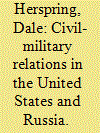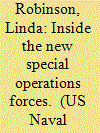| Srl | Item |
| 1 |
ID:
088937


|
|
|
|
|
| Publication |
2009.
|
| Summary/Abstract |
The key to understanding civil-military relations in polities such as Russia and the United States is military culture. Military culture includes a variety of characteristics or norms of behavior. Some such as executive leadership, respect for military expertise, and a clear chain of command are critical and exist in both the American and Russian militaries. Looking at two periods in both countries (Yeltsin and George Bush II, and Putin and George Bush I), this article maintains that in those instances when military culture was ignored in either country (e.g., a lack of executive leadership, little respect for military expertise, and lack of a clear chain of command), conflict not only existed but also was acerbated. Conversely, in cases where the civilians were firmly in charge but respected military culture, conflict was minimized. Senior military officers felt free to express their opinions and had the perception that their views were always taken seriously.
|
|
|
|
|
|
|
|
|
|
|
|
|
|
|
|
| 2 |
ID:
096455


|
|
|
| 3 |
ID:
132589


|
|
|
|
|
| Publication |
2014.
|
| Summary/Abstract |
Integrated-fires capabilities are a central part of the asymmetric advantage our Navy, joint, and coalition forces bring to a fight. They include capabilities that disrupt adversary command and control, communication, computing, intelligence, surveillance, and reconnaissance (C4ISR) Systems; deliver electronic payloads that limit an enemy's freedom of maneuver and action; and enhance the ability of our own forces to place ordnance on target. It integrates lethal and non-lethal fires, underpinned by superior battlespace awareness and assured command and control, to provide commanders an expanded set of warfighting tools especially important in anti-access and area-denial (A2/AD) environments, like Air-Sea Battle.
|
|
|
|
|
|
|
|
|
|
|
|
|
|
|
|
| 4 |
ID:
085461


|
|
|
|
|
| Publication |
2008.
|
| Summary/Abstract |
No nation can develop its security policy by disregarding its geopolitical factors. The United State (US) is regarded to be "an insular power of continental size", which is geopolitically located between the Pacific Ocean and the Atlantic Ocean. Therefore the ocean, especially the Pacific Ocean can be source of security or insecurity, depending on the balance if naval power.
|
|
|
|
|
|
|
|
|
|
|
|
|
|
|
|